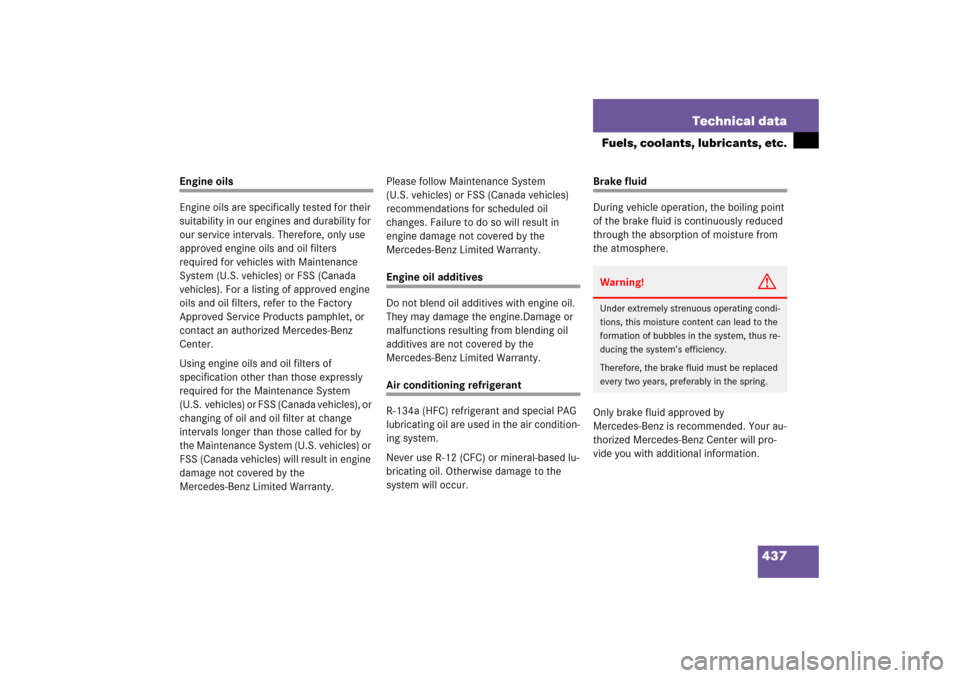Page 9 of 481

ContentsTechnical data.................................. 419
Parts service ...................................... 420
Warranty coverage ............................. 421
Loss of Service and Warranty
Information Booklet...................... 421
Identification labels............................ 422
Layout of poly-V-belt drive ................. 423
S 350/S 430/S 430 4MATIC/
S 500/ S 500 4MATIC ................. 423
S 55 AMG ..................................... 423
S 600 and S 65 AMG.................... 423
Engine ................................................ 424
Rims and tires .................................... 426
Same size tires ............................. 428
Mixed size tires ............................ 430
Spare wheel ................................. 431
Electrical system................................ 432Main dimensions and weights............ 433
Main dimensions .......................... 433
Weights ........................................ 433
Fuels, coolants, lubricants, etc. ......... 434
Capacities .................................... 434
Engine oils.................................... 437
Engine oil additives ...................... 437
Air conditioning refrigerant .......... 437
Brake fluid .................................... 437
Premium unleaded gasoline ......... 438
Fuel requirements ........................ 438
Gasoline additives ........................ 439
Coolants....................................... 439
Windshield and headlamp
washer system ............................. 442
Technical terms............................... 443Index................................................. 451
Page 203 of 481

202 Controls in detailAutomatic climate controlAir conditioning
The air conditioning is operational while
the engine is running and cools the interior
air to the temperature set by the operator.
Deactivating
It is possible to deactivate the air condi-
tioning (cooling) function of the automatic
climate control system. The air in the vehi-
cle will then no longer be cooled or dehu-
midified.�
Press button± (
�page 193).
The indicator lamp on the button±
comes on.Activating
Moist air can fog up the windows. You can
dehumidify the air with the air condition-
ing.
�
Press± again (
�page 193).
The indicator lamp on button ±
goes out.
The air conditioning uses the refrigerant
R134a. This refrigerant is free of CFCs
which are harmful to the ozone layer.
Residual heat and ventilation
With the engine switched off, it is possible
to continue to heat or ventilate the interior.
This feature makes use of the residual heat
produced by the engine.
Activating�
Turn the SmartKey in the starter switch
to position1 or 0, or remove it from the
starter switch.
�
Press buttonT (
�page 193).
The indicator lamp on buttonT
comes on.
iCondensation may drip out from under-
neath the vehicle. This is normal and
not an indication of a malfunction.
!If button± on the automatic cli-
mate control panel starts to flash, this
indicates that the air conditioning is
losing refrigerant. The compressor has
turned itself off. The air conditioning
cannot be turned on again.
Have the air conditioning checked at
the nearest authorized Mercedes-Benz
Center.
Page 437 of 481
436 Technical dataFuels, coolants, lubricants, etc.
Model
Capacity
Fuels, coolants, lubricants, etc.
Fuel tank
All models
23.2 US gal (88.0 l)
Premium unleaded gasoline:
Minimum Posted Octane 91
(Avg. of 96 RON/86 MON)
including a reserve of
All models except
S55AMG, S65AMG
2.9 US gal (11.0 l)
including a reserve of
S55AMG, S65AMG
3.7 US gal (14.0 l)
Air conditioning system
All models
R-134a refrigerant and special PAG
lubricant oil (never R-12)
Windshield washer
S 350
S 430, S 430 4MATIC
3.2 US qt. (3.0 l)
MB Windshield Washer Concentrate
1
1Use MB Windshield Washer Concentrate “S” and water for temperatures above freezing or MB Windshield Washer Concentrate “S” and commercially available pre-
mixed windshield washer solvent/antifreeze for temperatures below freezing point. Follow suggested mixing ratios (�page 442).Windshield washer and
headlamp cleaning system*
All models
7.1 US qt (6.7 l)
MB Windshield Washer Concentrate
1
Page 438 of 481

437 Technical data
Fuels, coolants, lubricants, etc.
Engine oils
Engine oils are specifically tested for their
suitability in our engines and durability for
our service intervals. Therefore, only use
approved engine oils and oil filters
required for vehicles with Maintenance
System (U.S. vehicles) or FSS (Canada
vehicles). For a listing of approved engine
oils and oil filters, refer to the Factory
Approved Service Products pamphlet, or
contact an authorized Mercedes-Benz
Center.
Using engine oils and oil filters of
specification other than those expressly
required for the Maintenance System
(U.S. vehicles) or FSS (Canada vehicles), or
changing of oil and oil filter at change
intervals longer than those called for by
the Maintenance System (U.S. vehicles) or
FSS (Canada vehicles) will result in engine
damage not covered by the
Mercedes-Benz Limited Warranty.Please follow Maintenance System
(U.S. vehicles) or FSS (Canada vehicles)
recommendations for scheduled oil
changes. Failure to do so will result in
engine damage not covered by the
Mercedes-Benz Limited Warranty.
Engine oil additives
Do not blend oil additives with engine oil.
They may damage the engine.Damage or
malfunctions resulting from blending oil
additives are not covered by the
Mercedes-Benz Limited Warranty.Air conditioning refrigerant
R-134a (HFC) refrigerant and special PAG
lubricating oil are used in the air condition-
ing system.
Never use R-12 (CFC) or mineral-based lu-
bricating oil. Otherwise damage to the
system will occur.
Brake fluid
During vehicle operation, the boiling point
of the brake fluid is continuously reduced
through the absorption of moisture from
the atmosphere.
Only brake fluid approved by
Mercedes-Benz is recommended. Your au-
thorized Mercedes-Benz Center will pro-
vide you with additional information.Warning!
G
Under extremely strenuous operating condi-
tions, this moisture content can lead to the
formation of bubbles in the system, thus re-
ducing the system’s efficiency.
Therefore, the brake fluid must be replaced
every two years, preferably in the spring.